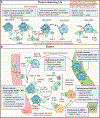Dendritic cells as shepherds of T cell immunity in cancer
- PMID: 37708889
- PMCID: PMC10591862
- DOI: 10.1016/j.immuni.2023.08.014
Dendritic cells as shepherds of T cell immunity in cancer
Abstract
In cancer patients, dendritic cells (DCs) in tumor-draining lymph nodes can present antigens to naive T cells in ways that break immunological tolerance. The clonally expanded progeny of primed T cells are further regulated by DCs at tumor sites. Intratumoral DCs can both provide survival signals to and drive effector differentiation of incoming T cells, thereby locally enhancing antitumor immunity; however, the paucity of intratumoral DCs or their expression of immunoregulatory molecules often limits antitumor T cell responses. Here, we review the current understanding of DC-T cell interactions at both priming and effector sites of immune responses. We place emerging insights into DC functions in tumor immunity in the context of DC development, ontogeny, and functions in other settings and propose that DCs control at least two T cell-associated checkpoints of the cancer immunity cycle. Our understanding of both checkpoints has implications for the development of new approaches to cancer immunotherapy.
Copyright © 2023 Elsevier Inc. All rights reserved.
Conflict of interest statement
Declaration of interests M.J.P. has served as a consultant for Acthera, AstraZeneca, Debiopharm, Elstar Therapeutics, ImmuneOncia, KSQ Therapeutics, MaxiVax, Merck, Molecular Partners, Siamab Therapeutics, Third Rock Ventures, and Tidal. T.R.M. is a co-founder and consultant, and M.D.P. is a consultant for Monopteros Therapeutics. C.G. has served as a consultant for Cellino Biotech.
Figures




References
-
- Spranger S, Luke JJ, Bao R, Zha Y, Hernandez KM, Li Y, Gajewski AP, Andrade J, and Gajewski TF (2016). Density of immunogenic antigens does not explain the presence or absence of the T-cell-inflamed tumor microenvironment in melanoma. Proc Natl Acad Sci U S A 113, E7759–E7768. 10.1073/pnas.1609376113. - DOI - PMC - PubMed
Publication types
MeSH terms
Grants and funding
LinkOut - more resources
Full Text Sources
Medical

